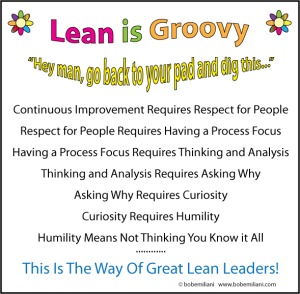One of things I tell my undergraduate and graduate students at the start of the semester is: “Your success in this course will be determined by your ability to follow instructions.” Invariably, the students with the highest marks follow instructions, while those with the lowest marks ignore instructions.
 The same is true for Lean transformations. The ability of a leader to transform an organization from conventional management to Lean management is determined by their ability to follow instructions. Think about some of the leading Lean success stories: Art Byrne’s leadership of The Wiremold Company (see Better Thinking, Better Results) and Dr. Gary Kaplan’s leadership of Virginia Mason Medical Center (see Transforming Health Care). These leaders listened to their kaizen consultants – in both cases, Chihiro Nakao, the leader of Shingijutsu USA. They followed Mr. Nakao’s specific instructions as well as his general guidance whose purpose was to help them in their own discovery and learning process.
The same is true for Lean transformations. The ability of a leader to transform an organization from conventional management to Lean management is determined by their ability to follow instructions. Think about some of the leading Lean success stories: Art Byrne’s leadership of The Wiremold Company (see Better Thinking, Better Results) and Dr. Gary Kaplan’s leadership of Virginia Mason Medical Center (see Transforming Health Care). These leaders listened to their kaizen consultants – in both cases, Chihiro Nakao, the leader of Shingijutsu USA. They followed Mr. Nakao’s specific instructions as well as his general guidance whose purpose was to help them in their own discovery and learning process.
Think also about the notable Lean failures, such as Tesco, whose leaders ignored the instructions and guidance from the people whom they hired for help (e.g. former TMUK people), or the many Lean failures across entire industries such as aerospace.
What kind of instructions and guidance must top leaders follow? Many of these you are familiar with:
- Participate in kaizen
- Learn Lean principles, methods, and tools hands-on, and understand their significance through daily practice
- Be persistent
- Ask “Why?”, and lead by example so that others ask “Why?”
- Don’t blame people for problems
- Allow people to think, which, in turn leads to boundless creativity and innovation
- Focus on flow
- Don’t lay people off
- Etc.
This reminds us of an important requirement that most top leaders do not possess, and which limits their ability to follow instructions and guidance from sensei: Humility. Most top leader cannot let go of their current batch-and-queue knowledge and practices and acquire new Lean knowledge and practices.
Related to humility is another important characteristic: Curiosity. Most top leaders are incurious. Art Byrne and Gary Kaplan are humble, curious leaders who are eager to learn new things and ry them out. And, when something does not work out as planned, they try again and again and again. They don’t give up after the first try as most leaders do.
In most organization, you cannot even tell the boss when they are wrong. Hierarchies, unwritten protocols, and organizational politics block information flows, which assures that important information remains hidden and work that needs to get done doesn’t. Needless to say, leaders who do not like to hear the truth cannot follow either specific instructions or general guidance. Their Lean transformations are domed to failure from the start.
